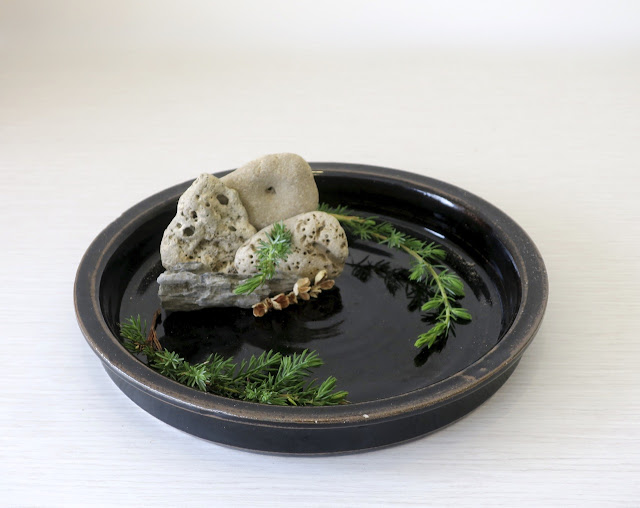A belated thank you to Michael Beedenbender for identifying the Lions Mane, Leonotis leonurus, that Maureen used in her ikebana posted on 19th February.
A couple of weeks ago I set my Torquay and Geelong students the task of creating an ikebana that incorporated stone. For practical reasons the additional proviso was to use a suiban as the vessel. The idea was that the stone(s) would be a coherent and necessary part of the design, not simply used as a device to conceal the kenzan. Most of the resulting ikebana works had a decidedly landscape feel to them.
Róża used Coastal Beard-Heath, Leucopogon parviflorus, and Gardenia, set in a shallow hand-made ceramic dish. She placed irregularly-shaped white pebbles in the vessel and continued their line to the left, thereby extending the line of the design.
Coralie used curving stems of Cypress and some dried seed pods as her botanical material. She had created a small mass with mismatched stones, each of which had holes in them. Together these gave an impression of a cliff-face.
Marta used materials from her garden including Mr Lincoln roses and some fine stems with small pink flowers. She used two stones in her ikebana. One in front of the botanical materials and the second at the back of the suiban. This had the effect of emphasising the space behind the materials.
Judy used a small mass of miniature roses and a curling stem of Jasmine. A single large rock was placed to one side of the suiban, suggesting an island or a cliff-face.
Helen Q used Baby's tears, Soleirolia soleirolii, floating in a circular bowl. The three partially-submerged stones in the centre gave the impression of a quiet pool.
Maureen used green and pale-yellow materials only, in her strongly-textured ceramic bowl. The texture on the outside of the bowl gave the appearance of it being made stone. The principal group of materials arose from behind a single stone placed within the suiban, creating the appearance of a pond.
Christine used five stems of fine grass as her botanical material which she arranged to create two lines moving from the right to the left in her ikebana. With a single large stone set on the righthand side, the design was minimal and almost abstract.
Ellie used a single pink Gerbera, and five petals placed in her suiban. She arranged nine small cubes of granite in an asymmetrical design. Above the suiban was tied four lines of red paper-string. Ellie explained that having the string above the water surface drew the eye down to the materials including the partially-submerged granite cubes.
In last week's post I mentioned visiting the Warrandyte Pottery Expo for the first time. While there I came across the stall of Mr Terenobu Hirata, and was delighted to see this beautiful black vase. In his recent work Mr Hirata has developed a characteristic style by moulding his vessels into sinuous curves that create a sense of fluid movement. To my delight Laurie bought the vase as a birthday present for me...
... and I was very happy to give it a new home. Yesterday I made this ikebana using Sedum, Autumn Joy, from the garden and some Dietes grandiflora leaves. The flexibility of the leaves allowed me to create some flowing lines that have complemented the vessel.
Greetings from Christopher
12th March 2022










I really like the Quiet pool and Single stone pond arrangements. That’s a lovely birthday present from Laurie:)
ReplyDelete